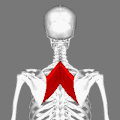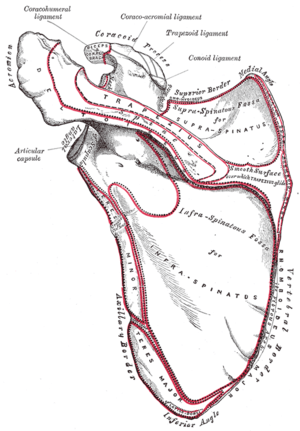Rhomboid muscles
The rhomboid muscles (/ˈrɒmbɔɪd/), often simply called the rhomboids, are rhombus-shaped muscles associated with the scapula. There are two rhomboid muscles on each side of the upper back:[1][2][3]
| Rhomboid muscle | |
|---|---|
Muscles connecting the upper extremity to the vertebral column. | |
| Details | |
| Origin | nuchal ligaments, spinous processes of the C7 to T5 vertebrae |
| Insertion | medial border of the scapula |
| Artery | dorsal scapular artery |
| Nerve | dorsal scapular nerve |
| Actions | Pulls scapulae medially, rotates scapulae, Holds scapluae into thorax wall |
| Identifiers | |
| Latin | musculi rhomboidei |
| TA | A04.3.01.007 A04.3.01.008 |
| Anatomical terms of muscle | |
The large rhombus-shaped muscle, located under the trapezius muscle in the upper part of the thoracic region of the back, and also the small muscle, in the same way, participate in the movement of the scapula.[4]
Anatomy
Rhomboid major muscle originates from the spinous processes of vertebrae T2-T5, while it inserts to the medial border of scapula. The rhomboid minor muscle originates from the nuchal ligament and spinous processes of vertebrae C7-T1. Both muscles are innervated by the dorsal scapular nerve, a branch of the brachial plexus. Their functions are the following:[1][2][3]
- Drawing scapula superomedially
- Supporting scapula
- Rotating glenoid cavity inferiorly
Additional images
 Rhomboid muscles.
Rhomboid muscles. Rhomboid muscles.
Rhomboid muscles. Left scapula. Posterior surface.
Left scapula. Posterior surface. Full back muscle flex
Full back muscle flex
References
- Standring, Susan, ed. (2016). Gray's anatomy: the anatomical basis of clinical practice (41st ed.). [Philadelphia]: Elsevier. ISBN 9780702052309. OCLC 920806541.
- Moore, Keith L.; Dalley, Arthur F., II; Agur, A. M. R. (2014). Clinically oriented anatomy (7th ed.). Philadelphia: Lippincott Williams & Wilkins. ISBN 1451119453. OCLC 813301028.
- "Rhomboid muscles". Kenhub. Retrieved September 27, 2019.
- "Rhomboid Muscle Pain". RhomboidMusclePain. Retrieved November 13, 2019.
| Wikimedia Commons has media related to Rhomboid muscles. |